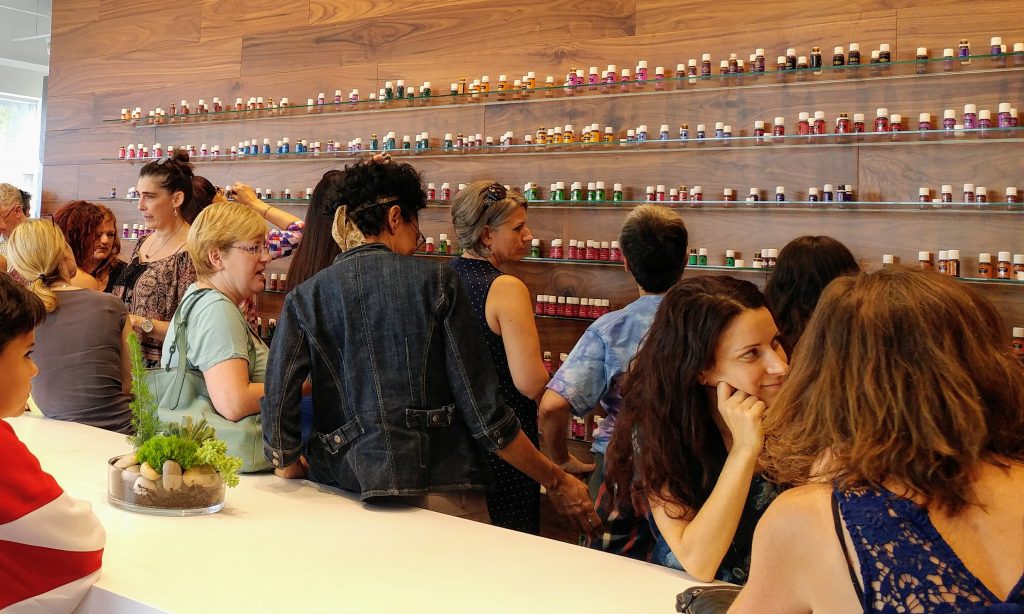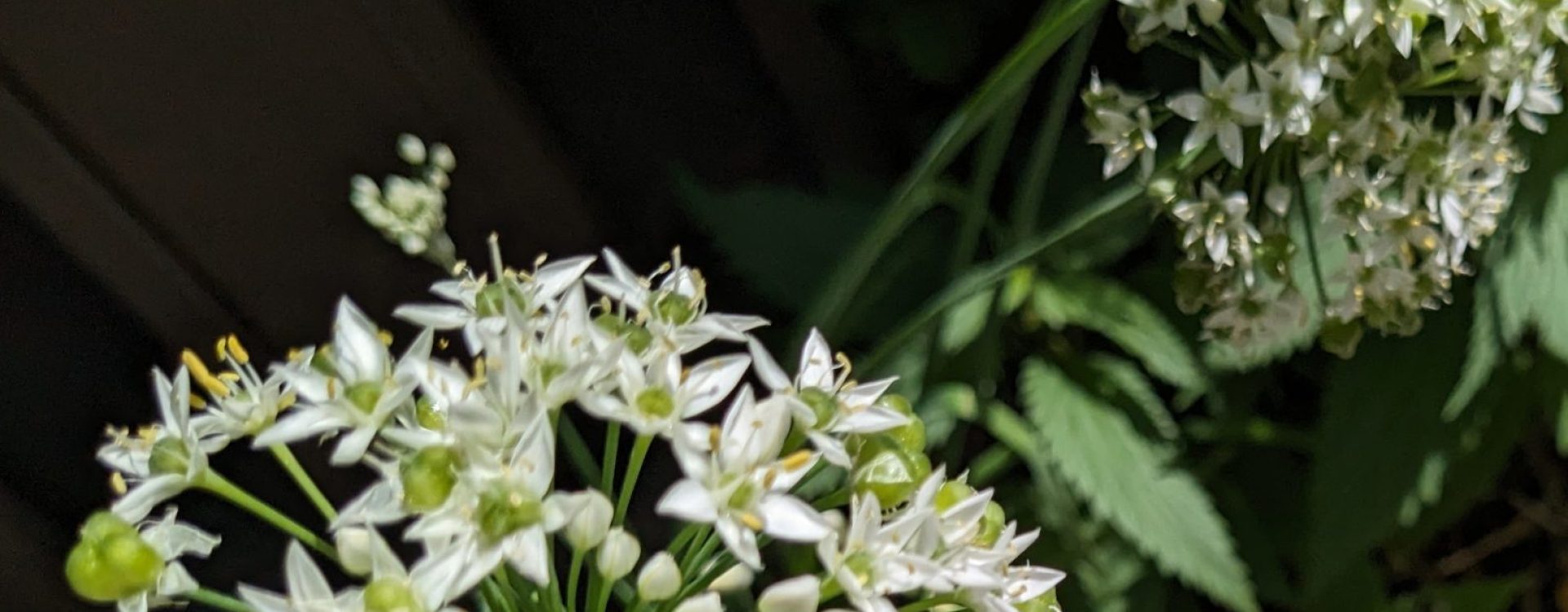About Essential Oils…
*** by Sarah Harnish – hear about her in the audio.
Essential oils are distilled from shrubs, flowers, trees, roots, bushes, fruit, rinds, resins, and herbs. Not every plant can be a good source for it. Essential Oils consist of over 100 different natural, organic compounds.
Listen to the audio below.
They are used extensively for emotional and spiritual support. An oil in a diffuser can soothe a child’s tough day at school and provide a calming effect when you’ve had a stressful day at work. They can be used for cleaning and in cosmetic products too.
There are about 300 oils on the earth, but you only need ten to twenty of them to build a good home kit.
You do not need to be an aromatherapist to use them, but you need to know quite a bit to use them without causing unknowingly harm. In most cases, just use them topically on your skin, in miniscule quantities. Sometimes less than a drop is enough. There are three main ways to get oils into your system: The English apply it topically – rub it on the skin (dilution often required); the French ingest and cook with it, knowing how to do it; the Germans diffuse and inhale, which can be the most effective method because it doesn’t have to pass through the digestive system.
How do they enter – and how long do they last?
Tests have shown oils reach the heart, liver, and thyroid in 3 seconds when inhaled; they were found in bloodstream in 26 seconds when applied topically. Expulsion of oils takes 3-6 hours in a normal, healthy body.
Do Essential Oils work?
Before knowing anything about essential oils, I have used them for years. Lavender smelled nice in my bath, but never had any significant effect on my body. I used to buy my Lavender cheap online, at farmers markets, or at bulk food stores. Then I learned that FDA requirement in order to label a bottle of essential oil “pure” or “therapeutic” grade, the contents of that bottle must contain at least 5 percent of essential oil! That’s it? The question arises – what is in the remaining 95% of that bottle?
All oils in the world fall into one of 4 categories, according to distilling procedures: Grade A, B, C or D.
Grade A – is therapeutic, made from organically grown plants and distilled at low temperatures.
Grade B oils are food grade, but may contain synthetics, pesticides, ferilizers, chemical extenders, or carrier oils.
Grade C oils are perfume oils that often contain adulterating chemicals. They usually use solvents, for example industrial alcohol hexane, to gain a higher yield of oil per harvest. Solvents can be cancerous, and are in many store-bought oils. They may also be diluted 80-95 percent with alcohol.
Grade D is called “floral water”, which is aromatic only and is usually byproduct of Grade A distillation. After all the oil is pulled out, the leftover trash water is sold to companies which fill 5 percent of the bottle with this “leftover trash water”, and fill the rest with carriers, and label it “pure”.
Grade A is the only true pure oil. Grade D would be like walking into your fridge, taking a glass of orange juice and diluting it 95 percent before you drank it! It wouldn’t have the full benefits of orange juice.
That’s why you want Grade A oils. Before you purchase, check to see to what degree the company controls the whole production from end to end. Do they use previously farmed land, control which seeds are used, grow their own plants, and control the entire process from the seed to the sealed bottle. Do they test each produced batch? Pesticides, pollution, previously farmed land, simplified distillation, not enough testing – all of it can effect the quality of an oil.

Why do oil companies sell cheaper oils?
To save money. If you spray the crop with pesticides, you have more crop to distill. If you use a chemical solvent to extract the oil, you pull more out. If you dilute it with a cheaper oil or a carrier oil, you stretch the oil you have distilled. Most essential oils are sold cheaper because companies cut corners.
How oils are made
It takes a great deal of work to produce a tiny amount of essential oil!
- 60 thousand rose blossoms provide only one ounce of rose oil
- Lavender is abundant – 220 pounds will provide 7 pounds of oil
- Jasmine flowers must be picked by hand before the sun becomes hot on the very first day they open, thus making it one of the most expensive oils in the world!. It takes 8 million hand-picked blossoms to produce 2.2 pounds of oil.
- A Sandalwood tree must be 3o years old and 30 feet high before it can be cut down for distillation.
But a little goes a long way. A 5 ml bottle contains 85 drops, and 15 ml bottle contains about 250 drops. Each application is 1-3 drops, meaning even a small bottle will get you 45 to 90 applications.
Thieves cleaner bottle replaces a multi-purpose cleaner, glass cleaner, and floor cleaner, at a price lower than organic version of any of those.
Are they safe?
There are certain oils that are photosensitive, meaning you don’t want to wear them and go to the sunny outside. These are mostly citrus oils, like grapefruit, lemon, tangerine, orange and bergamot.
When using on your skin, always dilute with a carrier oil and watch for redness. Dilute oils on children, because their skin is more permeable and absorbs the oils more quickly. Carrier oil is a fatty oil like olive oil or coconut oil, jojoba or sweet almond. Its molecules are much larger than those of the essential oils, and therefore they slow down the rate the body can absorb the essential oil, because it has to ping pong through the large molecules of the carrier oil to get into your skin.
Be wary of putting the oils topically near your eyes. Some oils, like peppermint, can cause a burning sensation, If you are placing an oil near your eye, apply the oils to a Q-tip instead of tipping the bottle toward your face.
You can become desensitized to an oil if you use the same one day after day, so I rotate my oils every three to four days.
What about internal use of essential oils?
NAHA, one of the top aromatherapy schools in the US, doesn’t advocate essential oils for internal use. Why? Most oil companies don’t carry any GRAS (Generally Regarded As Safe) essential oils which have been cleared by the FDA. NAHA also bases a lot of their decisions on the British model, which advocates topical use only. Many of the British studies are flawed, for example, done at the extremely high doses or in ways the oils aren’t used, like pouring a bottle inside the body. Don’t ever do that!
On the flip side…
Look at the ingredients list of what you have in your bathroom and kitchen. Every day we put products on our skin, in our body, on our lips, and breathe them, but many of these products contain damaging chemicals. The average woman applies over 300 chemicals a day to her body just through soaps, makeup, shampoos, and hair products. Eighty of those before breakfast!
Is all this a bit overwhelming? Let me tell you how I started my oils journey: with a Young Living starter kit. It’s the only thing on the Young Living website that is priced way below its value. If you are a frugal mom like me, this is the best bang for your buck!
First, open the bottle and smell it:
Frankincense. One of the top spiritual and skin oils. Helps smooth the appearance of skin. Diffuse during prayer time to help with grounding and purpose.
Lavender. Oil of relaxation. Diffuse for a calming, soothing aroma. Unwind by adding a few drops to a nighttime bath. One of the top oils to support healthy skin. Called the “Swiss army knife” of essential oils because of its many uses.
Peppermint. Supports gastrointestinal comfort, promotes healthy bowel function and enhanced healthy gut function (with external use on one’s belly). May support performance during exercise and lower muscles soreness when applied before exercise.
Purification. Diffuse to freshen the air and eliminate odours. Add to a carrier oil to moisturize your skin or for a soothing massage on your feet. Use in a spray to enjoy an annoyance-free outdoor experience.
Thieves. Helps support a healthy respiratory system and maintain overall wellness when rubbed on one’s chest.
Stress Away. Promotes wellness feeling, one of the top emotional oils, when applied on the left side of the neck, or wrists.
Lemon. Its citrus flavour enhances the taste of food. Don’t cook it, use on dipstick to mix with liquid food. It shouldn’t be floating on top of drink. A key ingredient in Thieves and NingXia Red.
PanAway. Apply after exercise to soothe muscles. Has a stimulating aroma. Apply to back and neck for a soothing aromatic experience. Supports the appearance of healthy skin coloration.
Copaiba. Promotes overall wellness. Also a great skin oil.
DiGize. Top oil for supporting the digestive system. Rub a few drops on stomach or belly.
R.C. Contains eucalyptol. Supports a healthy respiratory system. Diffuse for a comforting aroma. Rub on feet and chest.
Membership is not necessary to purchase products from Young Living online.
Welcome to the world of oils!
* Content of this page is based on Sarah Harnisch classes, and published with her permission. Sarah is Young Living leader and educator, certified Aromatherapist, a Mom of five, and an author of several books.

Image from the Young Living Experience Centre in Brampton, Ontario, Canada, September 2017
